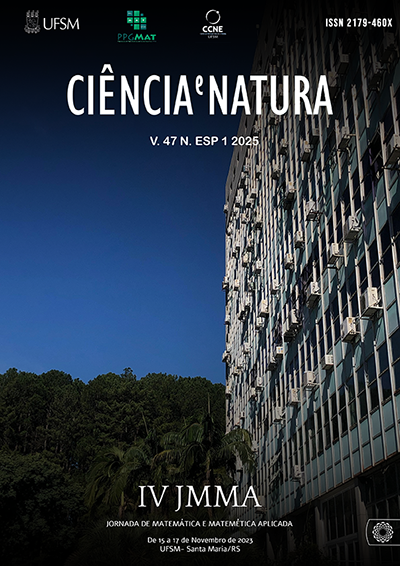The asymptotic homogenization method applied to the elastostatic model of functionally graded microperiodic Euler-Bernoulli beams
DOI:
https://doi.org/10.5902/2179460X90550Keywords:
Euler-Bernoulli beam, Asymptotic homogenization method, Formal asymptotic solution, Homogenized and local problemsAbstract
This work presents the application of the asymptotic homogenization method to a problem which models the mechanical equilibrium of functionally graded microperiodic Euler-Bernoulli beams clamped at both ends and subjected to a microperiodic distributed load. The five-term formal asymptotic solution is obtained in terms of the solution of the homogenized problem and the periodic solutions of the local problems, for whose existence a new result is presented. Analytical expressions for the homogenized and local solutions are provided. The exact solution of the problem, which is seldom available, is also provided for comparison purposes.
Downloads
References
Bakhvalov, N. & Panasenko, G. (1989). Homogenisation: Averaging Processes in Periodic Media: Mathematical Problems in the Mechanics of Composite Material. (MASS Series, 1st ed.). Springer Netherlands. DOI: https://doi.org/10.1007/978-94-009-2247-1_1
Bensoussan, A., Lions, J., & Papanicolau, G. (1978). Asymptotic Analysis for Periodic Structures. (MAEE series, 5th vol.). North Holland.
Ciouranescu, D. & Donato, P. (2000). An Introduction to Homogenization. (17th vol.). Oxford University Press.
Huang, Z., Xing, Y., & Gao, Y. (2020). A two-scale asymptotic expansion method for periodic composite Euler beams. Composite Structures, 241:112033. DOI: https://doi.org/10.1016/j.compstruct.2020.112033
Rao, S. S. (2016). Mechanical Vibrations. (6th ed.). Harlow: Pearson.
Silva, D. M., P´erez-Fern´andez, L. D., Molter, A., & Bravo-Castillero, J. (2023). M´etodo de homogeneizac¸ ˜ao assint´otica aplicado ao modelo de vigas de Euler-Bernoulli est´atico. Anais da Jornada de Matem´atica e Matem´atica Aplicada. S˜ao Paulo, SP, Brazil, 4.
Tartar, L. (2009). The General Theory of Homogenization: A Personalized Introduction. UMILN. (UMILN series, 7th vol.). Springer.
Torquato, S. (2002). Random Heterogeneus Materials: Microstructure and Macroscopic properties. (IAM series, 16th ed.). Springer
Downloads
Published
How to Cite
Issue
Section
License
Copyright (c) 2025 Ciência e Natura

This work is licensed under a Creative Commons Attribution-NonCommercial-ShareAlike 4.0 International License.
To access the DECLARATION AND TRANSFER OF COPYRIGHT AUTHOR’S DECLARATION AND COPYRIGHT LICENSE click here.
Ethical Guidelines for Journal Publication
The Ciência e Natura journal is committed to ensuring ethics in publication and quality of articles.
Conformance to standards of ethical behavior is therefore expected of all parties involved: Authors, Editors, Reviewers, and the Publisher.
In particular,
Authors: Authors should present an objective discussion of the significance of research work as well as sufficient detail and references to permit others to replicate the experiments. Fraudulent or knowingly inaccurate statements constitute unethical behavior and are unacceptable. Review Articles should also be objective, comprehensive, and accurate accounts of the state of the art. The Authors should ensure that their work is entirely original works, and if the work and/or words of others have been used, this has been appropriately acknowledged. Plagiarism in all its forms constitutes unethical publishing behavior and is unacceptable. Submitting the same manuscript to more than one journal concurrently constitutes unethical publishing behavior and is unacceptable. Authors should not submit articles describing essentially the same research to more than one journal. The corresponding Author should ensure that there is a full consensus of all Co-authors in approving the final version of the paper and its submission for publication.
Editors: Editors should evaluate manuscripts exclusively on the basis of their academic merit. An Editor must not use unpublished information in the editor's own research without the express written consent of the Author. Editors should take reasonable responsive measures when ethical complaints have been presented concerning a submitted manuscript or published paper.
Reviewers: Any manuscripts received for review must be treated as confidential documents. Privileged information or ideas obtained through peer review must be kept confidential and not used for personal advantage. Reviewers should be conducted objectively, and observations should be formulated clearly with supporting arguments, so that Authors can use them for improving the paper. Any selected Reviewer who feels unqualified to review the research reported in a manuscript or knows that its prompt review will be impossible should notify the Editor and excuse himself from the review process. Reviewers should not consider manuscripts in which they have conflicts of interest resulting from competitive, collaborative, or other relationships or connections with any of the authors, companies, or institutions connected to the papers.






